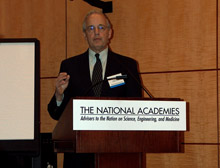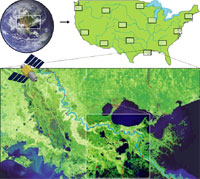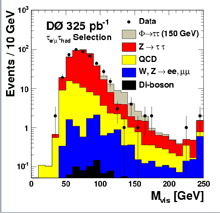 | Thursday, May 11, 2006 |
|
Thursday, May 11 11:00 a.m. Academic Lecture Series - Curia II Speaker: D. Green, Fermilab Title: High-pt Hadron Collider Physics - Course 8 (2nd Lecture) 2:30 p.m. Theoretical Physics Seminar - Curia II Speaker: F. Petriello, University of Wisconsin/Fermilab Title: Getting Ready for the LHC: QCD at Next-To-Leading Order and Beyond 3:30 p.m. DIRECTOR'S COFFEE BREAK - 2nd Flr X-Over 4:00 p.m. Accelerator Physics and Technology Seminar - 1 West Speaker: M. Furman, Lawrence Berkeley National Laboratory Title: Electron Cloud Simulations for the LHC and Main Injector
Friday, May 12
Saturday, May 13 |
|
Extended Forecast |
Secon Level 3 |
|
Thursday, May 11 -Tomato Florentine -Grilled Chicken Cordon Bleu Sandwich -Chimichangas -Chicken Marsala -Smoked Turkey Melt -Assorted Pizza -SW Chicken Salad with Roasted Corn Salad |
|
Thursday, May 11
Wednesday, May 17
Chez Leon Menu |
| Fermilab Today is online at: http://www.fnal.gov/today/ Send comments and suggestions to today@fnal.gov Fermilab Today archive Hurricane Relief Page Fermilab Today PDF Version Fermilab Result of the Week archive Fermilab Safety Tip of the Week archive Linear Collider News archive Fermilab Today classifieds Subscribe/Unsubscribe to |
| From the Director |
The recent EPP2010 report, Revealing the Hidden Nature of Space and Time,
has special relevance to the future of Fermilab. I encourage all Fermilab
employees to attend a briefing on the report by EPP2010 members Sally Dawson
and Chuck Shank, on Friday at 1:30 p.m. in Ramsey Auditorium.
--Pier Oddone |
|
|||
|
As chair of the National Academies' EPP2010 committee, the last 18 months have been an intellectual adventure. The journey was sometimes discouraging, sometimes inspiring, and finally quite exhilarating as I came to more fully appreciate the thrill of the emerging scientific agenda in particle physics. I am grateful to have had this opportunity and delighted to have begun to understand (and come to share) the enthusiasm and excitement that currently characterize the elementary particle physics community worldwide. Indeed, particle physics is facing its most compelling scientific agenda in a generation. The task before our committee was to recommend a strategic vision and a set of priorities that would stand the best chance of enabling the U.S. program to fully participate in the unfolding of this agenda.
The product of our long effort, assisted mightily by our colleagues here and abroad, Revealing the Hidden Nature of Space and Time: Charting the Course for Elementary Particle Physics, represents our response to this challenge. Two of my colleagues from the committee, vice chair Sally Dawson and committee member Charles Shank, will be sharing the report with the Fermilab community this Friday. Just a few weeks later, and as part of the annual users meeting, committee member Norman Augustine and I will be at Fermilab, in part to discuss the report at greater length.
|
CLEANER's Vision for the WATERS Network
| ||
|
As population levels and the rate of urban development rise, our society grows increasingly concerned with balancing the need to maintain water supplies of adequate quantity and quality for human use with preserving the integrity of aquatic ecosystems. Common practices associated with modern living often negatively impact the environment. Commercial fertilization of agricultural fields can result in significant run-off of nutrients and microorganisms into nearby surface waters. In some U.S. cities, untreated stormwater, containing substantial loadings of pathogens and chemicals, is discharged into the nearest body of water. And along some major U.S. rivers, drinking water intakes are located downstream from wastewater treatment plants. Because many of these issues are tied to where people live and work, scientists and engineers must also factor in social and economic impacts when considering solutions to these problems.
Read More |
|
The Courier News May 10, 2006: Maintaining Fermilab at physics frontier Mention the words "particle physics" and most people begin to go cross-eyed. But the study of this arcane subject has led scientists around the world to a greater understanding of how the universe is formed, what is inside an atom and what new particles are out there in space. For years, brilliant American scientists have dominated the field of particle physics and the investigations into the nature of matter, space, energy and time - the very origins of the universe itself.
But now, some of our most prominent researchers are worried we will lose ground in this very important field. "The U.S. position of leadership is not secure," reports a group of scientists connected to the National Academies. We face competition from Japan and Europe, and the U.S. scientists warned that in order to retain our lead in this field, we need to support the next state-of-the-art particle accelerator - a linear collider - a project that would impact residents of Illinois and northwest Indiana. If this new accelerator is built in the United States, it would be here, at the Fermi National Accelerator Laboratory in Batavia.
|
| Hunting for SUSY-Higgs with Taus |
|
One area where modern theories remain incomplete is the explanation
why the matter particles that make up our universe carry the
masses we
observe. Furthermore, the solution most natural to the Standard
Model of particle physics is increasingly regarded as insufficient.
A modern
theory, called Supersymmetry (or SUSY), attempts to remedy this issue
by postulating a set of new particles (superpartners) paired with
each particle already observed. In its simplest form, SUSY predicts
five different particles (called Higgs bosons) responsible for
particle masses. As they are all unstable, they decay to other
particles quickly after being produced. The three neutral Higgs
bosons (the other two are charged) can decay to pairs of tau leptons (heavy
brethren of electrons: m_tau ~ 3500m_e), which represents a rare
physical signature in the data. Detecting an excess of events with
tau pairs beyond that predicted by current models could indicate new
physics. However, taus also decay very quickly (less than a
trillionth of a second) and are hard to identify.
To overcome this challenge, Dzero utilizes a sophisticated pattern
recognition process using neural networks. These are mathematical
models that mimic the way the brain processes information. This
process allows physicists to identify taus, hence
Higgs-like events, and thereby constrain the theoretical
parameters of SUSY. Although 17 candidate events are currently
observed in the DZero data, they are consistent with the standard
model, hence offering no evidence of new physics. This result
complements a previous search pioneered by DZero for events
containing at least three b quarks (Result of the Week 4/14/2005).
By combining
these two searches, DZero is able to constrain an even broader range
SUSY Higgs models and allow us to gauge the good potential of the
Tevatron to discover SUSY Higgs bosons, if they exist, in the future. |
| Result of the Week Archive
|
|
EPP2010 Committee members to speak at Fermilab tomorrow, May 12 The EPP2010 report made headlines on Thursday. What does it say about the future of Fermilab? Find out more tomorrow, when EPP2010 Committee member Chuck Shank and Committee co-chair Sally Dawson come to speak to the Fermilab community. They will discuss the report at a 1:30 p.m. meeting in the Ramsey Auditorium. Everyone at Fermilab is invited to attend.
The Fermilab Association of Rocketry
Striping D Road
Batavia Road entrance closed to cars and bicycles
Main Ring Road, near A0, closed Monday-Friday |





